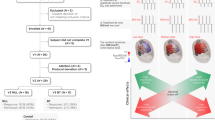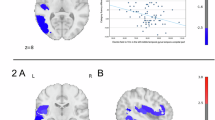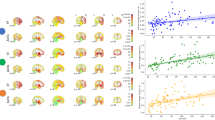Abstract
Lowering and individualizing the current amplitude in electroconvulsive therapy (ECT) has been proposed as a means to produce stimulation closer to the neural activation threshold and more focal seizure induction, which could potentially reduce cognitive side effects. However, the effect of current amplitude on the electric field (E-field) in the brain has not been previously linked to the current amplitude threshold for seizure induction. We coupled MRI-based E-field models with amplitude titrations of motor threshold (MT) and seizure threshold (ST) in four nonhuman primates (NHPs) to determine the strength, distribution, and focality of stimulation in the brain for four ECT electrode configurations (bilateral, bifrontal, right-unilateral, and frontomedial) and magnetic seizure therapy (MST) with cap coil on vertex. At the amplitude-titrated ST, the stimulated brain subvolume (23–63%) was significantly less than for conventional ECT with high, fixed current (94–99%). The focality of amplitude-titrated right-unilateral ECT (25%) was comparable to cap coil MST (23%), demonstrating that ECT with a low current amplitude and focal electrode placement can induce seizures with E-field as focal as MST, although these electrode and coil configurations affect differently specific brain regions. Individualizing the current amplitude reduced interindividual variation in the stimulation focality by 40–53% for ECT and 26% for MST, supporting amplitude individualization as a means of dosing especially for ECT. There was an overall significant correlation between the measured amplitude-titrated ST and the prediction of the E-field models, supporting a potential role of these models in dosing of ECT and MST. These findings may guide the development of seizure therapy dosing paradigms with improved risk/benefit ratio.
Similar content being viewed by others
Log in or create a free account to read this content
Gain free access to this article, as well as selected content from this journal and more on nature.com
or
References
Cretaz E, Brunoni AR, Lafer B (2015). Magnetic seizure therapy for unipolar and bipolar depression: a systematic review. Neural Plast 2015: 521398.
Deng Z-D (2013) . Electromagnetic field modeling of transcranial electric and magnetic stimulation: targeting, individualization, and safety of convulsive and subconvulsive applications. PhD thesis, Columbia University, New York, NY, USA.
Deng ZD, Lisanby SH, Peterchev AV (2011). Electric field strength and focality in electroconvulsive therapy and magnetic seizure therapy: a finite element simulation study. J Neural Eng 8: 016007.
Deng ZD, Lisanby SH, Peterchev AV (2013a). Controlling stimulation strength and focality in electroconvulsive therapy via current amplitude and electrode size and spacing: comparison with magnetic seizure therapy. J ECT 29: 325–335.
Deng ZD, Lisanby SH, Peterchev AV (2013b). Electric field depth-focality tradeoff in transcranial magnetic stimulation: simulation comparison of 50 coil designs. Brain Stimul 6: 1–13.
Deng ZD, Lisanby SH, Peterchev AV (2015). Effect of anatomical variability on electric field characteristics of electroconvulsive therapy and magnetic seizure therapy: a parametric modeling study. IEEE Trans Neural Syst Rehabil Eng 23: 22–31.
Kayser S, Bewernick BH, Matusch A, Hurlemann R, Soehle M, Schlaepfer TE (2015). Magnetic seizure therapy in treatment-resistant depression: clinical, neuropsychological and metabolic effects. Psychol Med 45: 1073–1092.
Kellner CH, Fink M, Knapp R, Petrides G, Husain M, Rummans T et al (2005). Relief of expressed suicidal intent by ECT: a consortium for research in ECT study. Am J Psychiatry 162: 977–982.
Kellner CH, Knapp R, Husain MM, Rasmussen K, Sampson S, Cullum M et al (2010). Bifrontal, bitemporal and right unilateral electrode placement in ECT: randomised trial. Br J Psychiatry 196: 226–234.
Lee WH, Deng ZD, Kim TS, Laine AF, Lisanby SH, Peterchev AV (2012a). Regional electric field induced by electroconvulsive therapy in a realistic finite element head model: influence of white matter anisotropic conductivity. Neuroimage 59: 2110–2123.
Lee WH, Lisanby SH, Laine AF, Peterchev AV (2012b). Stimulation strength and focality of electroconvulsive therapy with individualized current amplitude: a preclinical study. Conf Proc IEEE Eng Med Biol Soc 2012: 6430–6433.
Lee WH, Lisanby SH, Laine AF, Peterchev AV (2013). Electric field characteristics of electroconvulsive therapy with individualized current amplitude: a preclinical study. Conf Proc IEEE Eng Med Biol Soc 2013: 3082–3085.
Lee WH, Lisanby SH, Laine AF, Peterchev AV (2015). Electric field model of transcranial electric stimulation in nonhuman primates: correspondence to individual motor threshold. IEEE Trans Biomed Eng 62: 2095–2105.
Lee WH, Lisanby SH, Laine AF, Peterchev AV (2016). Comparison of electric field strength and spatial distribution of electroconvulsive therapy and magnetic seizure therapy in a realistic human head model. Eur Psychiatry 36: 55–64.
Liberson WT (1948). Brief stimulus therapy; psysiological and clinical observations. Am J Psychiatry 105: 28–39.
Lisanby SH, Moscrip T, Morales O, Luber B, Schroeder C, Sackeim HA (2003). Neurophysiological characterization of magnetic seizure therapy (MST) in non-human primates. Suppl Clin Neurophysiol 56: 81–99.
Loo CK, Katalinic N, Smith DJ, Ingram A, Dowling N, Martin D et al (2014). A randomized controlled trial of brief and ultrabrief pulse right unilateral electroconvulsive therapy. Int J Neuropsychopharmacol 18: 1–8.
Mayur P, Harris A, Gangadhar B (2015). 500-mA ECT-a proof of concept report. J ECT 31: e23–e26.
Nahas Z, Short B, Burns C, Archer M, Schmidt M, Prudic J et al (2013). A feasibility study of a new method for electrically producing seizures in man: focal electrically administered seizure therapy [FEAST]. Brain Stimul 6: 403–408.
Passingham R (2009). How good is the macaque monkey model of the human brain? Curr Opin Neurobiol 19: 6–11.
Paxinos G, Huang XF, Toga AW (2000) The Rhesus Monkey Brain in Stereotaxic Coordinates. Academic Press: San Diego, CA, USA.
Peterchev AV, Krystal AD, Rosa MA, Lisanby SH (2015). Individualized low-amplitude seizure therapy: minimizing current for electroconvulsive therapy and magnetic seizure therapy. Neuropsychopharmacology 40: 2076–2084.
Peterchev AV, Rosa MA, Deng ZD, Prudic J, Lisanby SH (2010). Electroconvulsive therapy stimulus parameters: rethinkingdosage. J ECT 26: 159–174.
Pons JP, Segonne E, Boissonnat JD, Rineau L, Yvinec M, Keriven R (2007). High-quality consistent meshing of multi-label datasets. Inf Process Med Imaging 20: 198–210.
Rasmussen KG (2015) Improving ECT efficacy and decreasing cognitive side effects. In: Reti IM (ed). Brain Stimulation: Methodologies and Interventions. Wiley Blackwell: Hoboken, NJ, USA, pp 83–106.
Reti IM (2015) How does electroconvulsive therapy work? In: Reti IM (ed). Brain Stimulation: Methodologies and Interventions. Wiley Blackwell: Hoboken, NJ, USA, pp 107–122.
Rosa MA, Abdo GL, Lisanby SH, Peterchev AV (2011). Seizure induction with low-amplitude-current (0.5 A) electroconvulsive therapy. J ECT 27: 341–342.
Rosa MA, Abdo GL, Rosa MO, Lisanby SH, Peterchev AV (2012). Fronto-medial electrode placement with low current amplitude: a case report. J ECT 28: 146.
Rossini PM, Barker AT, Berardelli A, Caramia MD, Caruso G, Cracco RQ et al (1994). Non-invasive electrical and magnetic stimulation of the brain, spinal cord and roots: basic principles and procedures for routine clinical application. Report of an IFCN committee. Electroencephalogr Clin Neurophysiol 91: 79–92.
Sackeim HA (2004). Convulsant and anticonvulsant properties of electroconvulsive therapy: towards a focal form of brain stimulation. Clin Neurosci Res 4: 39–57.
Sackeim HA, Prudic J, Devanand DP, Nobler MS, Lisanby SH, Peyser S et al (2000). A prospective, randomized, double-blind comparison of bilateral and right unilateral electroconvulsive therapy at different stimulus intensities. Arch Gen Psychiat 57: 425–434.
Saleem KS, Logothetis NK (2007) A Combined MRI and Histology Atlas of the Rhesus Monkey Brain in Stereotaxic Coordinates, 1st edn. Elsevier/Academic Press: Amsterdam, The Netherlands; Boston, MA, USA, 336–pp.
Semkovska M, Landau S, Dunne R, Kolshus E, Kavanagh A, Jelovac A et al (2016). Bitemporal versus high-dose unilateral twice-weekly electroconvulsive therapy for depression (EFFECT-Dep): a pragmatic, randomized, non-inferiority trial. Am J Psychiatry 173: 408–417.
Sun Y, Farzan F, Mulsant BH, Rajji TK, Fitzgerald PB, Barr MS et al (2016). Indicators for remission of suicidal ideation following magnetic seizure therapy in patients with treatment-resistant depression. JAMA Psychiatry 73: 337–345.
Tor PC, Bautovich A, Wang MJ, Martin D, Harvey SB, Loo C (2015). A systematic review and meta-analysis of brief versus ultrabrief right unilateral electroconvulsive therapy for depression. J Clin Psychiatry 76: e1092–e1098.
Weiner RD (2015) Introduction to convulsive therapy. In: Reti IM (ed). Brain Stimulation: Methodologies and Interventions. Wiley Blackwell: Hoboken, NJ, USA, pp 61–82.
Youssef NA, Sidhom E (2014). Examination of cognitive profile and variability in the current amplitude domain of low current amplitude ECT. Biol Psychiatry 75: 259s–260s.
Acknowledgements
We thank Dr Paolo Maccarini and Dr Murali Kadiramangalam for the ANSYS license donation. Preliminary results from this study were presented in part in conference proceedings (Lee et al, 2012b, 2013).
Author information
Authors and Affiliations
Corresponding author
Additional information
Supplementary Information accompanies the paper on the Neuropsychopharmacology website
Supplementary information
Rights and permissions
About this article
Cite this article
Lee, W., Lisanby, S., Laine, A. et al. Minimum Electric Field Exposure for Seizure Induction with Electroconvulsive Therapy and Magnetic Seizure Therapy. Neuropsychopharmacol 42, 1192–1200 (2017). https://doi.org/10.1038/npp.2016.276
Received:
Revised:
Accepted:
Published:
Issue date:
DOI: https://doi.org/10.1038/npp.2016.276
This article is cited by
-
How electroconvulsive therapy works in the treatment of depression: is it the seizure, the electricity, or both?
Neuropsychopharmacology (2024)
-
Advances in precision neuromodulation: electroconvulsive therapy amplitude titration
Neuropsychopharmacology (2024)
-
Amplitude-determined seizure-threshold, electric field modeling, and electroconvulsive therapy antidepressant and cognitive outcomes
Neuropsychopharmacology (2024)
-
On assumptions and key issues in electric field modeling for ECT
Molecular Psychiatry (2024)
-
Cerebro-cerebellar functional neuroplasticity mediates the effect of electric field on electroconvulsive therapy outcomes
Translational Psychiatry (2023)



